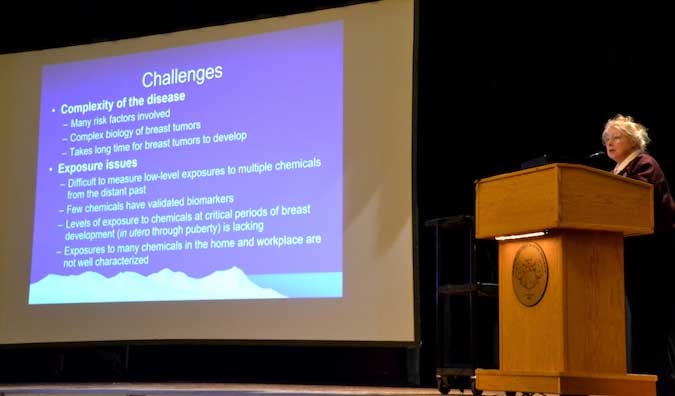No easy answers in determining if Albion teachers have elevated cancer rate
‘You could spend tens of thousands of dollars testing for hundreds of things. But you may never get that aha moment where we know why this happening.’
ALBION – The leader of numerous studies on elevated breast cancer rates addressed Albion teachers and the community on Thursday, and said it’s possible that the elementary school teachers and staff have a high rate of breast cancer.
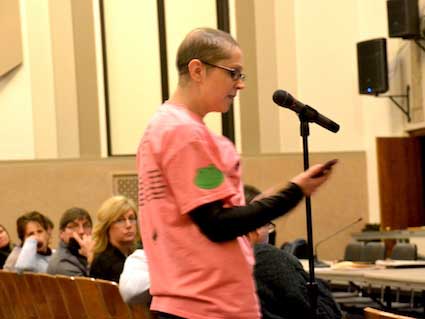
Angie Wolfe, who has battled breast cancer the past year, said many staff members at the school have been diagnosed with breast cancer recently, including 9 in the past 5 years, and 15 in the past 10 years.
Nellie Brown, director of the Workplace Health and Safety Program for Cornell University’s School of Industrial and Labor Relations, spoke for more than an hour, outlining numerous chemicals that can be potential causes of breast cancer or “endocrine disrupters.” She helped develop the database of chemicals known to cause cancer and worked for the Program on Breast cancer and Environmental Factors at Cornell from 1995 to 2009.
Brown said Americans have been bombarded with chemicals since they were in the womb, and tracing a specific impact on a person may be impossible to determine, given the exposures may have been decades ago at an unknown amount.
“We are surrounded by synthetics and dust,” she said.
There could be a study of the elementary school environment to rule out potential causes, such as the ventilation systems, cleaning products, and chemicals used at science labs, art classes and woodshop. There could be a chemical analysis of air contaminants, measuring particulates.
(Nearby industry, groundwater and soil contamination have been factors in elevated rates in other locations, she said.)
There is emerging science that shows endocrine disrupters play a role in developing cancer, Brown told about 50 people on Thursday evening during a 2-hour meeting in the middle school auditorium.

James Bowers, an epidemiologist who studies diseases for the state Department of Health, speaks at Thursday’s meeting in the middle school auditorium.
There are more than 100 chemicals that have adverse impacts on humans and the world is seeing the impact, not only with elevated cancer rates, but with earlier puberty, lower sperm counts and higher rates of obesity, Brown said.
“We are being inundated with endocrine disrupters,” she said.
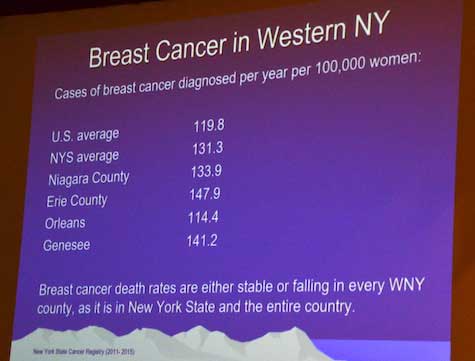
This is one of the slides shared by Nellie Brown during her presentation on Thursday.
Brown was the featured speaker during Thursday’s meeting, and was brought in by the district after the Albion Teachers Association raised concerns during the Jan. 7 Board of Education meeting, saying 22 teachers and staff at the school have been diagnosed with breast cancer in recent years, including nine in the past five years.
Brown said determining the causes of elevated breast cancer rates is challenging due to the complexity of the disease and many risk factors involved. It also takes a long time for breast tumors to develop, at least a decade after an exposure to a carcinogen.
If someone at the school has been diagnosed with breast cancer within a decade of working there, that person can rule out the school environment as a cause, said James Bowers, an epidemiologist who studies diseases for the state Department of Health.
He has done many studies on elevated cancer rates in communities including four at other schools this year.
To determine if there is a cancer cluster, Bowers looks to see if the cancer is the same type of the disease, the age of people when they were diagnosed (are there unusual age groups such as 20 to 30 years old instead of ages 50 to 70?), how long have worked there, where they live (many don’t live in the community where they work). He also wants to know how many people also worked in the building over five years, 10 years and longer, to determine the rates of cancer in the building.
“Twenty (diagnoses of cancer) in 10 years is a lot different than 20 in 30 years,” he said.
He would compare the incidence rate at the school with the rate in the community.
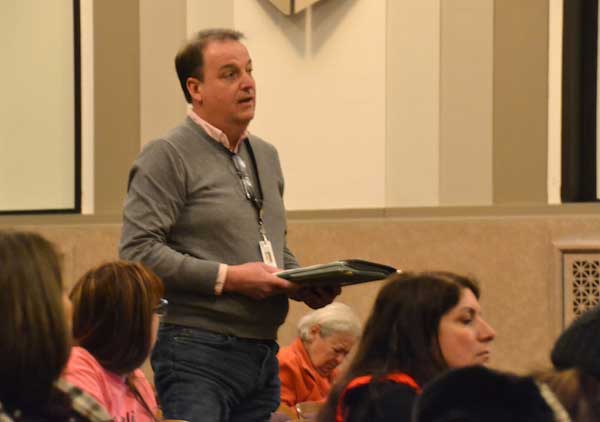
Chris Keller, president of the Albion Teachers Association, asks the Board of Education to pursue testing air quality in the elementary school.
Brown, the Cornell specialist, said breast cancer rates have been rising slightly in the United States. She shared data that shows the Orleans County rate is lower than in the average in Western New York, the state and nationally.
The Orleans County breast cancer rate of 114.4 per 100,000 women compared to the US average of 119.8, the NYS average of 131.3, and Niagara County, 133.9; Erie County, 147.9; and Genesee County, 141.2.
Sometimes in a smaller community when a teacher gets breast cancer, it is a “thunderclap” and spurs other teachers and staff to get checked, sometimes leading to early detections and a spike in diagnoses, Bowers said.
The fact is teachers do have elevated rates of breast cancer, Brown and Bowers said. That is a reality around the world. California, for example, has studied 133,000 teachers. That state has an elevated rate of breast cancer in teachers. After years of exhaustive study, there isn’t a definitive cause for the elevated cancer rates.
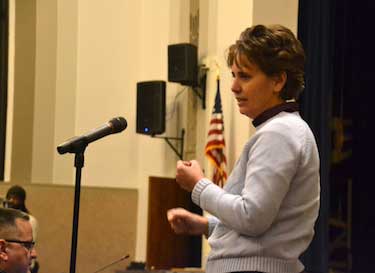
Margy Brown, president of the Board of Education, said the board has safety as a top priority.
“You could spend tens of thousands of dollars testing for hundreds of things,” Bowers said. “But you may never get that aha moment where we know why this happening.”
Brown highlighted some risks related to breast cancer: advancing age, late menopause, lack of exercise, overweight, alcohol, diet, smoking, genetics, close relative, light exposure at night, and chemicals at work, home, garden and recreation.
There is also some evidence of higher breast cancer risk if exposure to acid mists, benzene, carbon tetrachloride, ethylene oxide, formaldehyde, lead oxide, methylene chloride and styrene.
Brown again said it is challenging to determine the cause of breast cancer. It is difficult to measure low-level exposures to multiple chemicals from the distant past, Brown said.
The levels of exposure at critical periods of breast development (in utero through puberty) also is largely unknown. And exposures to many chemicals in the home and workplace are not well characterized.
“The number of items is so dang ubiquitous it can be hard to avoid them,” she said.
The chemicals can be disrupt the endocrine glands, which control the body processes of growth, development, reproduction, homeostasis and metabolism – from conception through adulthood into old age.
Endocrine disrupting chemicals can mimic hormones and interfere with delicate hormonal balances that control or affect the development of cancer, reproduction, neurobehavioral and the immune system, Brown said.
“Endocrine disruption has turned our views upside down,” she said. “Even a small dose can cause damage.”
After the presentations from Brown and Bowers, Chris Keller, president of the Teachers Association, asked that the school district study the air quality and ventilation in the buildings.
Nellie Brown said she could do a test in about a day with cooperation from the buildings and grounds, checking ventilation and air quality.
Margy Brown, president of the Albion Board of Education, said the board and school officials will discuss the next step. The board has a meeting on Monday.
“I assure you we are looking at this,” Brown told the group at the meeting. “We have brought the experts in and we will formulate a plan based on what they tell us.”




























